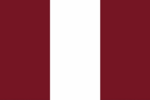Alliria

|
Kingdom of Alliria Ons'Allir (Allirian) Capital: Latanka
Population: 37,758,159 (2021) Anthem: "Orkgoste ỳ Màmaylэhz̨i" |
Loading map... |
Alliria (Allirian: Alliríz̨i [ˈaˌlɪɾiʒɨ]), officially the Kingdom of Alliria (Allirian: Ons’Allir [ˈɔ̃s.alɪɾ]), is a country in southwestern Uletha, on the southern end of the Ghetorian Peninsula. It borders Mazan to the north, Aden and Arion to the west, Karkinos and the Sea of Uthyra to the south, and the Asperic Ocean to the east, where it shares a maritime border with Valony in the Barzi Strait. Alliria also controls several islands in the Asperic and Sea of Uthyra, most notably Barzi and Djinoua. The total area of Alliria is 90,953km², with an estimated population of 37,758,159 in 2021, making it one of the most densely populated countries in Uletha, with a population density of 410/km². Latanka is the country's capital and largest city, a megacity home to over a third of the entire population. It is also a global city and the focal point for Allirian culture, transport and the economy. Other important cities include Thessanaiaka, Bazravopolis, Hallefainess, Suanna, Vantarya, Loszov, and Faghaiapolis.
Allliria is a sovereign state and a federal monarchy, divided into 16 states each with varying degrees of constitutional autonomy from the federal government. These states vary greatly in both size and population. Each state elects councillors to the Federal Delegation, the Upper House of the Parliament, with the number of members corresponding to the population of the state. Today, Alliria is a modern democratic nation, ranked as a flawed democracy on the Democracy Index. Alliria's history as a democracy is short, however its parliamentary system today is the result of a complex formation of states over millennia, with each state developing from nationalistic, ethnic, and linguistic divisions.
Inhabited since prehistoric times, the area today known as Alliria developed as one of the earliest civilisations. Archaeological evidence of this is concentrated around Lake Pag and the north-eastern area of the country, where it is presumed numerous city states existed and traded with the Proto-Mazanic tribes from the north. Latanka is thought to have been founded during this period, and is considered one of the longest continually inhabited cities in the world. Early Allirian civilisation entered a steep decline around the arrival of Hellanesians to the peninsula as early as 1900BC, and relatively little is known about them today. From then onwards, Hellanesian language and culture heavily influenced Alliria. During the first century AD, the Romantian Empire swept through the Ghetorian Peninsula, and briefly conquered Hellanesian Alliria. The empire was at almost constant warfare with the Allirians during this time, and wasn't able to hold onto it as a province. The region fractured into numerous states in 97AD, the most important of those being Vatteras and Latankas. These two states fought a series of dynastic conflicts lasting several hundred years until they were united by King Heri I in 491AD, proclaimed the first king of a united Allirian state and the beginning of the Vatteran dynasty that has lasted to this day. Through the middle ages Alliria grew as a regional power and developed strong trade relations in the Mediterranean and greater southern Uletha. The Latanka and Loszov grew into important centres of trade for the wider region, allowing Allirian culture to develop and flourish during its renaissance period.
| Kingdom of Alliria Ons'Allir | ||||
|---|---|---|---|---|
| Anthem: "Orkgoste ỳ Màmaylэhz̨i" (Allirian) The Call of the Motherland | ||||
| Capital | Latanka | |||
| Official languages | Allirian | |||
| • Regional languages | Barzic Cipisika Hellanesian Mazanic Patesic | |||
| Ethnic Groups (2019) | 83.51% Allir 11.31% Hellanesian 2.10% Mazanic 1.16% Patesi 1.92% Others | |||
| Government | Federal parliamentary constitutional monarchy | |||
| • Tsedov (Monarch) | Gz̨эnэvív V | |||
| • Prime Minister | Tvuolava Hcastasutr | |||
| Legislature | National Parliament | |||
| • Upper house | Federal Delegation | |||
| • Lower house | Daiara | |||
| Area | ||||
| • Total | 90,953 km2 35,117 sq mi | |||
| • Water (%) | 1.2 | |||
| Population | ||||
| • Estimate (2021) | ||||
| • Census (2019) | 37,301,691 | |||
| • Density | 410.1/km2 1,062.2/sq mi | |||
| GDP (PPP) | ||||
| • Total | $ 1.310 trillion | |||
| HDI (2021) | very high | |||
| Timezone | +3 | |||
| Currency | Allirian Kyryn (AKR) | |||
| Drives on the | right | |||
| ||||
Etymology
The name 'Alliria' comes from Romantish, meaning "land of the Allirs", referring to the Allir tribe who inhabited the area around modern day Latankas (and now the vast majority of the country), who were the first people the Romanish met on voyages from the Mediterranean. The origin of "Allir" itself is unclear, however some linguits have proposed it may have come from the ancient mythological god Alata, meaning "people of Alata".
In Alliria, Both Alliríz̨i and Э́ra (Allirian pronunciation: [ˈeʲːɾɑ]) are used to describe the country, with the latter best translating to 'home' (Although most Allirians would refer to their house as Gyvэntэ). Alliríz̨i is a naturalisation of the Romanish exonym Alliria, and became widely used after the Hellanesian conquest.
History
Geography
Government and Politics
Economy
Alliria's eastern coastline, known variously as the Allirian Seaboard, Maritime Alliria, and the Allirian Riviera, has been the economic and cultural powerhouse of the country since antiquity. Its relatively milder and more humid climate than the west makes agriculture far more productive. The low lying Duer Valley, stretching across the states of Bratvannskar, Faghai, benefits from the milder climate and serves as the breadbasket for the country